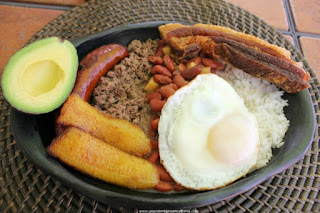COLOMBIA 6; LA COMIDA COLOMBIANA / A SHORT GUIDE TO COLOMBIAN FOOD
18/08/2022
(English in italics)
Una breve exploración de algunos platos típicos de
Colombia. Como en toda América Latina, la gente come mucho en las calles, o en
malls que están medio en el exterior (hay techos pero no paredes).
El precio de comer en los restaurantes o cafés típicos no
es muy alto. El otro día almorcé en un
pequeño restaurante al lado de una calle muy transitada. Me pusieron un plato grande
de arroz, aguacate, tajada, frijoles, carne de cerdo y arepas, y con dos
botellas de agua pagué 16,000 pesos, que parece mucho pero que es más o menos €3.50
😊.
A quick
exploration of some typical Colombian food. Just like in the whole of Latin
America there is a strong tradition of street food, and people often eat in the
streets, or in malls that are semi-outside (there are rooves but no walls).
The
prices in the restaurants, for Europeans, are cheap. The other day I had lunch
in this place by the side of a busy road near a park I was cycling in. I got a
dish with pork on the grill, rice, avocado, fried plantain, beans, arepas and
two bottles of water for 16,000 pesos. That sounds like a lot, but it is only
around €3.50 😊.
El chicharrón
Una fritura de la piel del cerdo, o de carne de cerdo con
piel.
A mí me encanta, me hace recordar mi infancia. Hacía años
que no comía el chicharrón, y redescubrirlo fue bonito. Es muy sabroso, y se
come en muchos platos colombianos.
Fried
pork rind or pork crackling.
I really
like chicharrón – I seem to remember eating pork crackling in my childhood,
years ago, but I hadn’t eaten it since then. It brings me back! It is tasty and
delicious and is used in a lot of Colombian dishes.
También forman parte de muchos platos colombianos (y
venezolanos). Es una comida precolombina, que originó con los pueblos indígenas
en el sur de América, antes de la llegada de los europeos.
Es básicamente un tipo de tortilla hecha a base de maíz, normalmente de una forma redonda. Para mí, las arepas son bastante sosas. No tienen mucho sabor y son un poco secos.
Existen otros tipos de arepas, rellenas de queso, con
huevos, con azúcar, pero las arepas básicas no me llaman mucho la atención, aunque
son una base de muchos platos aquí.
Arepas are
also a large part of a lot of dishes in Colombian (and Venezuelan) cooking. They
are a pre-colombian food, in other words they originated with the indigenous
peoples of South America, before Columbus and the Europeans arrived.
It is
basically a type of tortilla made from maize, usually in a round shape. For me,
arepas are quite bland. They don’t have a lot of flavour and they are a bit dry.
There are
other types of arepas, they are often filled with stuff like meat or cheese,
but the basic varieties do not do much for me.
Tajadas
 Estas sí que me encantan. Son plátanos cortados en lonjas
elongadas y fritas o horneadas.
Estas sí que me encantan. Son plátanos cortados en lonjas
elongadas y fritas o horneadas.
Se sirven con muchos platos, como las arepas. Son dulces
y blandos y añaden una
Now these
I do like. They are plantains cut longwise and fried or baked.
They are served with a lot of dishes, just like arepas. They are sweet and soft, and add a nice sweetness to any dish that has rice, meat and beans.
El adjetivo “paisa” se refiere a cualquier cosa que viene de la región de Antioquia, la
región que tiene Medellín como capital.
La bandeja paisa es típica de esta región y se come mucho
en Medellín, pero también en el resto del país. Consiste en morcilla, chorizo,
arroz, frijoles, un huevo frito, aguacate (siempre te preguntan si lo quieres “blando,
medio o duro”) y los ya mencionados chicharrón, arepas y tajadas.
Es un plato fuerte, como se puede ver. También, si te
gusta la carne y los embutidos, es delicioso, variado, sabroso. La mejor cosa
que he comido aquí.
“La
bandeja” is literally “the tray” and this is what this is like – like a tray
full of food. “Paisa” is anything related to Antioquia, the central region of
Colombia that Medellin is the capital of.
This dish
is typical of this region and is eaten a lot in Medellin, but also in the rest
of the country. It consists of morcilla (also eaten in Spain, a type of black
pudding), chorizo, beans, avocado, a fried egg (they always ask you if you want
it soft, medium or hard) and the already mentioned chicharron, arepas and fried
plantains.
It is a
heavy dish, as can be seen by the list of ingredients. Also, if you like meat
it is delicious, varied and tasty. The best thing I have eaten here.
Se denomina como una sopa, pero en realidad es más un cocido o un guisado. Puede tener pollo, carne de cerdo o carne de vaca. Lleva tomates, ajo, una mazorca de maíz, arroz, patatas, yuca y plátanos.
Yo lo tomé con albóndigas. La verdad es que parece que
hay muchas variedades de sancocho, y se puede meter muchas cosas en el plato. En
general está rico y sabroso, una comida impresionante.
Sancocho is
classed as a soup, but really it is more of a stew. It can contain chicken,
pork or beef. It usually has tomatoes, garlic, corn on the cob, rice, potatoes,
yuca and plantain.
I had it
with meatballs, though there seems to be a lot of different varieties, and you
can put a lot in the dish. In general it is rich and tasty, a real meal.
Mondongo
Otra sopa que es, fundamentalmente, toda una comida.
Una sopa de carne de cerdo, callos y verduras. Callos aquí es mondongo. No soy gran fan de callos, pero querría probar el plato, así que lo pedí mi última noche en Medellín.
Y sí, callos siguen sin gustarme. No entiendo como callos
pueden ser comida – es la parte interior del estómago de un animal. Y eso es lo
que parece en el plato. No, gracias.
Another
soup that is, fundamentally, a full meal.
A soup
with pork, tripe and vegetables. The “mondongo” here means tripe. I am not a big
fan of tripe, but I wanted to try the dish so I ordered it on my last night in
Medellín.
And yes, I
am still not a big fan of tripe. I am not really sure how we can call it food –
it is the lining of an animal’s stomach. And that is what it looks like in the
bowl. Eh, no, gracias.







Comments
Post a Comment